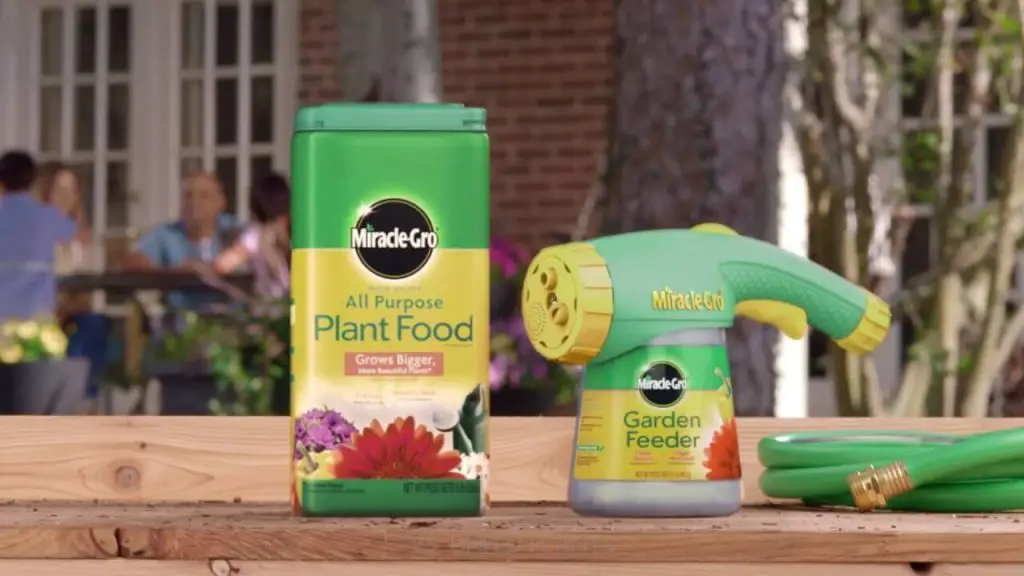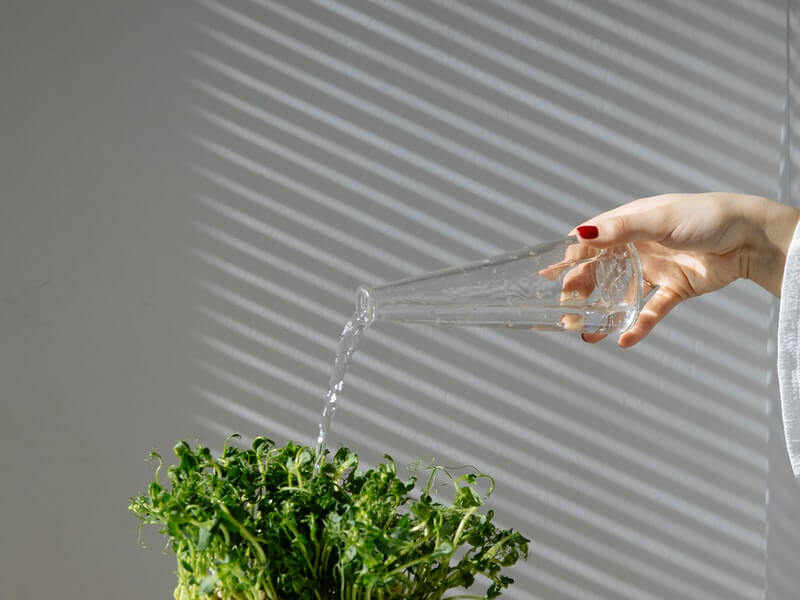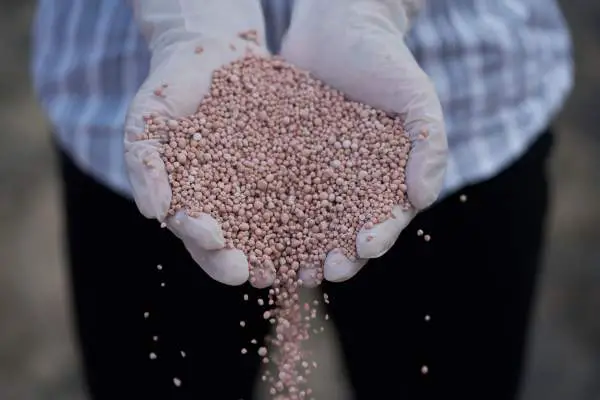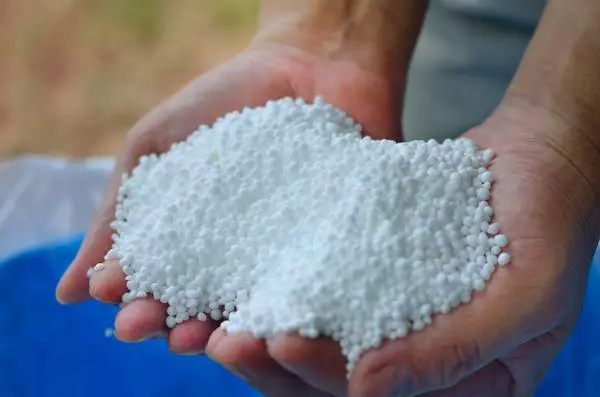This question doesn’t really have an easy answer because there are a few variables at play. To be entirely sure if Miracle-Gro can be used in a hydroponics system, we need to see if it contains all the elements which plants need for proper growth.
There are also other factors that might determine, not only its effectiveness for hydroponic use but also its suitability. This comes from the fact Miracle-Gro needs to be dissolved in water before use, whereas hydroponic nutrients in most cases for hobby or home growers are already in liquid form. This in itself might cause problems with hydroponic systems, which we will see.
There is also a vast difference in price between the two, and this reason alone can help you see why people decide to opt for Miracle-Gro rather than more expensive nutrients. Again, we will quickly find out if this is justified, or it is a false economy.
Does Miracle-Gro Contain the Correct Nutrient Composition?

Too Many or Too Little Nutrients
When growing in hydroponics, we need to be sure everything the plants need is delivered to them. Roots are unable to reach out in search of nutrients because they are growing in a soilless environment. For any nutrient solution to be considered, there are two factors we need to think about.
Does the nutrient solution contain all of the elements which are required for robust and healthy plant growth, and are they in the correct ratios? Secondly, these complete balanced solutions will be running at an EC (Electrical Conductivity) strength for different phases of plant growth, type of plant, and also the type of hydroponic system you are running.
When looking at this, we need to see if Miracle-Gro contains everything plants actually require for proper growth.
While not looking at individual crops, many hydroponic growers prefer ‘pre-mixed’ nutrients which only require being added to water. It is larger growers who have commercial systems which tend to opt for powdered variants and to mix their own. These ‘pre-mixed’ nutrients can be purchased in packs of 2 or 3 parts, and what this allows a grower to do, is alter the ratios for each phase of their plant’s growth.
When you look at Miracle-Gro, there is no option to do this as it only comes as a 1-part-solution, and already we can see there will be problems during some stage of plant growth. Miracle-Gro isn’t designed to be complete plant food, and it isn’t possible for regular fertilizer to deliver what plants want at each stage of growth.
Also see: Bloombastic vs. Big Bud
What Elements does a Complete Plant Food Require?
As we have seen, Miracle-Gro isn’t designed as being complete plant food. However, hydroponic nutrients are designed to be complete plant foods, and to be ‘complete’ a nutrient solution must contain the following:
- Nitrogen (N)
- Phosphorus (P)
- Potassium (K)
- Calcium (Ca)
- Zinc (Zn)
- Sulphur (S)
- Iron (Fe)
- Copper (Cu)
- Manganese (Mn)
- Magnesium (Mg)
- Boron (B)
- Chlorine (Cl)
- Molybdate (Mo)
There are secondary elements many of these nutrient solutions contain, and although not essential, they can be beneficial to plant growth. These are:
- Nickel (Ni)
- Cobalt (Co)
- Silica (Si) and/ or Selenium (Se)
Out of this list, the primary three nutrients are Nitrogen, Phosphorus, and Potassium. You will see this everywhere you look, but they will be related to most often as N-P-K. Without these, plants will die.
When you purchase hydroponic base nutrients, these ratios are displayed on the bottles. This is important because plants not only need the correct nutrients, they also need them to be in the proper ratios.
There are two stages a plant goes through during its life, and each of these requires a specific ratio of N-P-K for the best overall growth.
- The Vegetative phase (growing): Nitrogen (high), Phosphorus (medium) and Potassium (high)
- The Flowering stage (blooming): Nitrogen (low), Phosphorus (medium) and Potassium (high)
On an additional note: in the flowering stage, growers were led to believe the Phosphorus levels were to be much higher than is actually required.
Now, when we take a look at Miracle-Gro as a hydroponic solution, things take a downturn because there is no way to tailor any nutrient for your plants. This means they will be fed the same ratios of all nutrients through both phases of growth.
When we take a look at Miracle-Gro, it is easy to see they are missing quite a few essential elements, a couple of which are Calcium, Magnesium, Sulfur, and Chlorine. With this in mind, we have two phases of plant growth where you can only feed your plants the same nutrients.
Even adjusting the quantities, elements are missing, and you will end up altering the compound levels in the fertilizer without a way of controlling them.
Nutrient deficiencies that occur from using Miracle-Gro can display symptoms like, younger leaves becoming distorted, staying small in size, and dead areas from a lack of calcium. Magnesium deficiency symptoms are common in tomatoes where the older leaves develop yellow areas between the veins. This is very similar to leaves that wilt and yellow with dead spots that indicate a lack of chlorine being delivered to your plants.
Hydroponic Nutrients Vs. Miracle-Gro
As a quick example of how growers would use the two formulas, here is how they would be added to a hydroponics system.
Miracle-Gro: Mix 2 teaspoons for each gallon of water, and then add 1 teaspoon of Epsom salts for each gallon. Mix until dissolved, and only mix what you will use because the effectiveness wears off. When combined, the solution will be blue. Check and adjust pH levels with the right solution.
Hydroponic nutrients: Using one of the most popular hydroponic nutrient packs, you would take the three bottles which make up the ‘Flora’ line by General Hydroponics, and consists of: Grow, Bloom and Micro. All instructions are on the bottles for ratios to be mixed for each phase of your plant’s growth.
Add to your solution, no need for dissolving or mixing, and it is easy to make as you need it.
These can be adapted for different hydroponic systems and plant types at all of their growing phases to obtain the maximum growth possible. When you follow the instructions as indicated, your plants will grow fine, and there is no need for adding any additional nutrients. Check pH levels, but these nutrients do come with an included pH buffer to prevent spikes or drops in these levels.
Hydroponic nutrients also contain chelated trace elements, and although Miracle-Gro has some trace elements, these might not be chelated because this occurs naturally in a soil growing environment.
Feeding Your Plants and Nutrient Problems

As we feed plants, nutrient solutions are taken up, and water evaporates with EC levels rising. When this begins to happen, plants will start lacking nutrients. To measure the concentration of elements in our nutrient solutions, we perform an EC check, and although it isn’t possible to test for the concentration of each component, we can test for the overall PPM quickly.
When we submerge a digital PPM meter into the solution to take a reading, a normal EC level should range from 1000 to 1500 ppm. This can vary due to crops being grown, and also at the stage of their growth because you do need a higher PPM as your plants increase in size.
As this feeding pattern changes, pH levels can change, and it is crucial to adjust levels to balance them out. If the pH levels drift too far in either direction, our plants will start to suffer from nutrient lock-out where they are unable to absorb.
Again going back to Miracle-Gro and it being a 1-part-solution, we are unable to change any of these levels individually, and all that can be done is to increase or weaken the overall EC of the solution. This might sound as if we are doing the right thing. However, the individual nutrients will all be adjusted, instead of us being able to change specific areas.
This can result in using a weak solution, and because the ratio of certain nutrients was low to start with, our plants might be receiving next to zero. Additionally, the feeding time that is recommended when using Miracle-Gro in conventional gardening is every 7 – 14 days. With a feeding schedule more frequent than this in a hydroponic system, it can be, you overfeed your plants with a supply of nutrients that isn’t complete.
Other problems can stem from using Miracle-Gro because you are unable to control the levels of nutrients delivered, and it lacks certain nutrients. The issues can be as follows:
- Underfeeding: Plants appear pale due to a lack of nutrients.
- Overfeeding: You will be overfeeding certain nutrients without being aware. This leads to either nutrient burn, where your plants end up with dark spots on the tips of their leaves. Or, nutrient lockout where your plants are unable to absorb the nutrients they need.
When there is a nutrient deficiency, which will occur using Miracle-Gro further into a plant’s growth. Plants begin to droop, and if you have fruits, these can start to drop before they are ready. This happens because there aren’t the right nutrients in Miracle-Gro to support and sustain the production of fruit. Many hydroponic growers have tried Miracle-Gro and state that everything can appear okay in the first few weeks, but from this stage onward, it can go downhill where buds will not flower and end up falling.
This is though, dependent on your crop, but it shows there is a severe lack of nutrients at this stage of your plant’s growth.
Chasing your pH
As we know, pH levels will change when nutrients are added, or as water levels drop and the EC levels rise. Most often, hydroponic nutrients come with a pH buffer which helps maintain pH levels, although they do still need checking and adjusting as required.
Miracle-Gro on the other hand comes with no pH buffer, and the majority of Nitrogen (N) that is provided in the fertilizer is derived from urea. As a result, pH levels can drop significantly in your solution, and unfortunately, you have no way to adjust Nitrogen levels in a Miracle-Gro solution. Using a weaker concentration is not an answer because all other trace element levels will also be lowered, and can lead to many other problems.
Miracle-Gro and the Kratky Method
We have seen that Miracle-Gro much like other regular fertilizers isn’t suitable for hydroponic systems. Systems such as hydroponic drip or aeroponics systems can become clogged in nozzles and pipes due to the solution not being fully dissolved. There is then the lack of nutrients, and the inability to change the N-P-K levels for different phases of plant growth and salt build-up that can occur quicker than if using the proper nutrient solutions.
With all of this information, we can easily say not to use Miracle-Gro at all, but, there is one area of hydroponics where you can use Miracle-Gro where none of these problems should arise or cause too much concern.
This is with passive hydroponics. For anyone who is looking for an effortless way to grow, so they can have a hands-off experience, or they are looking to venture into hydroponics but want to save on the expense until they are confident. This can be an ideal introduction, and because Miracle-Gro costs next to nothing, and can be found anywhere, there is nothing to lose.
This passive hydroponics system doesn’t use any electricity, pumps, or air stones, and can be placed outdoors in a growing area, or indoors if you have the right grow lights.
The Kratky method was developed at the University of Hawaii by Bernard A. Kratky (horticulturist), is super simple and can be ideal for growing lettuce, spinach, or herbs. Plants like tomatoes or anything similar won’t grow to their full potential.
How to Grow Using the Kratky Method
Although this method is very straightforward, it does need steps to be followed. Here are the items you will require, and the steps you need to try this passive hydroponics method with Miracle-Gro.
Items required
- Plant seeds of choice
- Container with a lid you can cut – Styrofoam containers are ideal and easy to work with
- Water and your Miracle-Gro/ Epsom salt mixture
- A pH testing kit
- Net pots and growing medium. Rockwool or coco coir is ideal for this system
Steps for system construction
- Taking the lid of your container, you need to cut holes large enough for your net pots to sit, so they are flush with the cover.
- Fill your net pots with the growing medium and plant your seeds
- Mix your nutrient solution and fill the bottom part of the container. Be sure to test the pH and adjust if necessary. Smaller plants require shallower or smaller containers.
How this passive hydroponics system works
Once the seedling starts drawing water and solution into the net pot, the water levels in the Styrofoam container drop. This then creates a space where roots can obtain their oxygen. Once the water in the container has gone, it is time to harvest your plants.
One of the crucial parts of this easy system is the container lid. It creates the area for moist air to circulate around your plant’s roots, and secondly it provides the required support for plants above water level. The final benefit is the space between the lid increases the container’s aeration and allows heat to be removed from the nutrient solution.
For plants like lettuce and other leafy greens, this is one hydroponic solution where it is possible to use Miracle-Gro. For new growers, or as an introduction to hydroponics for children, there is nothing easier and as cheap to set up.
Conclusion
Armed with all the above information, you can see the use of Miracle-Gro is not recommended for use in hydroponics systems for quite a few reasons. Because it is a foolproof method of providing nutrients to soil-based gardens, this doesn’t make it ideal for hydroponics no matter what levels of concentration you use.
If your system becomes clogged and your solution flow is restricted, this has far more implications than merely flushing your system. Plants will be starved of nutrients and will no doubt suffer before you spot there is something wrong. You will also see toward the end of your plant’s growth, they lack the fullness and yield they deliver when using the proper nutrients which are designed for use in hydroponics.
One final thing to consider is the acquisition of General Hydroponics by the company that owns Miracle-Gro, via one of its subsidiaries, Hawthorne Gardening Co. If Miracle-Gro were a decent substitute for a hydroponics system, they would no doubt have either marketed Miracle-Gro as such or would have produced a variant that was suitable. Instead, they bought the most highly-regarded nutrient manufacturer. Is this a move to produce their own brand of nutrients, or is there another reason why they have purchased this company, along with the many other companies in this field?
Until the day arrives, growers are far better leaving Miracle-Gro for soil-based gardens or using it in the Kratky method for some hands-off hydroponic gardening. There is too much at stake with your system and your plants, to advise using a lower quality and cheaper form of fertilizer as a replacement for hydroponic nutrients that are proven to work.




